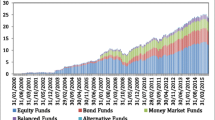Abstract
Empirical evidence shows that market prices of country exchange traded funds (ETFs) react in unison with domestic stocks on their listing exchange to a common set of risk factors. This would argue against the use of indirect foreign investments via country ETFs to diversify a portfolio of domestic stocks. Using the net asset values of a cross-section of US and European-listed ETFs to control for market noise and time zone discrepancies, this study seeks to quantify the diversification benefits of country ETFs for a domestic investor. Moreover, fund returns are decomposed into their two fundamental drivers – the variations of the underlying foreign stocks and the foreign currency – in order to investigate the role of currency returns in modifying correlations between country funds and domestic stocks. To conclude, the analysis is repeated for the pre- and post-financial crisis periods to gain insight into shifts in the relationships between world equity markets since this dislocation.






Similar content being viewed by others
Notes
As opposed to country funds, which only invest in stocks of a single country, international ETFs invest across countries or regions thereby presenting exposure to numerous foreign currencies.
Country funds investing in China, Hong Kong and Malaysia are therefore eliminated from the research.
Although the DJ Stoxx 600, which is quoted in euros, would be the equivalent broad measure of European equities, this index contains component stocks traded in sterling, francs and kronas. A currency-neutral measure of Euro-Zone equities is given by the Euro Stoxx index.
Direct quotes indicate the number of dollars (or euros) per unit of foreign currency. In this way a numerical increase corresponds with an appreciation of the foreign currency.
The traditional Pearson measure is given by, ρ NAV,D =(Cov(NAV,D))/(σ NAV σ D ), where Cov (NAV,D) is the covariance of the fund NAV and the domestic index returns, and σ NAV and σ D are the standard deviations associated with the tracker and index, respectively.
Phillips–Perron (1988) unit root tests are also used to confirm the ADF tests.
Complete test results are available from the author upon request.
References
Akaike, H. (1974) A new look at the statistical model identification. IEEE Transactions on Automatic Control 19 (6): 716–723.
Ben-Zion, U., Choi, J.J. and Hauser, S. (1996) The price linkages between country funds and national stock markets: Evidence from cointegration and causality tests of Germany, Japan and UK funds. Journal of Business Finance & Accounting 23 (7): 1005–1017.
BlackRock (2012) ETF Landscape: Industry Review Year End H1 2011.
Carrion-i-Silvestre, J.L. and Sanso, A. (2006) Testing the null of cointegration with structural breaks. Oxford Bulletin of Economics and Statistics 68 (5): 623–646.
Dickey, D.A. and Fuller, W.A. (1979) Distribution of the estimators for autoregressive time series with a unit root. Journal of the American Statistical Association 74 (366): 427–431.
Eaker, M. and Grant, D. (1985) Optimal hedging of uncertain and long-term foreign exchange exposure. Journal of Banking & Finance 9 (2): 221–231.
Engle, R. and Granger, C. (1987) Cointegration and error correction: Representation, estimation, and testing. Econometrica 55 (2): 251–276.
Errunza, V.R. and Padmanabhan, P. (1988) Further evidence on the benefits of portfolio investments in emerging markets. Financial Analysts Journal 44 (4): 76–78.
Eun, C.S. and Resnick, B.G. (1985) Currency factor in international portfolio diversification. Columbia Journal of World Business 20 (2): 45–53.
Forbes, K.J. and Rigobon, R. (2002) No contagion, only interdependence: Measuring stock market comovements. Journal of Finance 57 (5): 2223–2261.
Gagnon, L. and Andrew, K. (2009) Information, trading volume, and international stock return comovements: Evidence from cross-listed stocks. Journal of Financial and Quantitative Analysis 44 (4): 953–986.
Gastineau, G. (2001) Exchange-traded funds: An introduction. Journal of Portfolio Management 27 (3): 88–96.
Granger, C. (1980) Testing for causality: A personal viewpoint. Journal of Economic Dynamics and Control 2 (1): 329–352.
Gregory, A.W., Nason, J.M. and Watt, D.G. (1996) Testing for structural breaks in cointegrated relationships. Journal of Econometrics 71 (1): 321–341.
Grossmann, A. and Beach, S.L. (2010) Expanding a U.S. portfolio internationally: ADRs, their underlying assets, and ETFs. Financial Services Review 19 (1): 163–185.
Grubel, H. (1968) Internationally diversified portfolios: Welfare gains and capital flows. American Economic Review 58 (5): 1299–1315.
Johansen, S. (1988) Statistical analysis of cointegration vectors. Journal of Economic Dynamics and Control 12 (2): 231–254.
Hauser, S., Marcus, M. and Yaari, U. (1994) Investing in emerging stock markets: Is it worthwhile hedging foreign exchange risk? Journal of Portfolio Management 20 (3): 76–81.
Huberman, G. and Kandel, S. (1987) Mean-variance spanning. Journal of Finance 52 (4): 873–888.
Kwaitkowski, D., Philips, P., Schmidt, P. and Shin, Y. (1992) Testing the null hypothesis of stationarity against the alternative of a unit root. Journal of Econometrics 54 (1): 159–178.
Levy, H. and Sarnat, M. (1970) International diversification of investment portfolios. American Economic Review 60 (4): 668–692.
Markowitz, H. (1952) Portfolio selection. Journal of Finance 7 (1): 77–91.
Pennathur, A.K., Delacoure, N. and Anderson, D. (2002) Diversification benefits of iShares and closed-end country funds. Journal of Financial Research 36 (4): 541–557.
Perron, P. (1991) Test consistency with varying sampling frequency. Econometric Theory 7 (3): 341–368.
Phillips, P. and Perron, P. (1988) Testing for a unit root in time series regression. Biometrika 75 (2): 335–346.
Pukthuanthong, K. and Roll, R. (2009) Global market integration: An alternative measure and its application. Journal of Financial Economics 94 (2): 214–232.
Richards, A. (1995) Comovements in national stock market returns: Evidence of predictability, but not cointegration. Journal of Monetary Economics 36 (3): 631–654.
Roll, R. (1992) Industrial structure and the comparative behavior of international stock market indices. The Journal of Finance 47 (1): 3–41.
Schwarz, G. (1978) Estimating the dimension of a model. Annals of Statistics 6 (2): 461–464.
Solnik, B. (1974) Why not diversify internationally rather than domestically. Financial Analysts Journal 30 (4): 48–54.
Author information
Authors and Affiliations
Corresponding author
Rights and permissions
About this article
Cite this article
Williams, S. Country ETFs, currencies and international diversification. J Asset Manag 15, 392–414 (2014). https://doi.org/10.1057/jam.2014.28
Received:
Revised:
Published:
Issue Date:
DOI: https://doi.org/10.1057/jam.2014.28



